Previous Month | RSS/XML | Current | Next Month
WEBLOG
July 29th, 2025 (Permalink)
Lesson on Logic 20: Venn Diagrams, Invalidity and Counter-Examples
In previous lessons1, we saw how Venn diagrams are used to represent categorical statements and show the validity of arguments constructed with such statements. One advantage of such diagrams is that they also show the invalidity of invalid arguments. Since the diagrams represent the logical relations between the argument's classes, if the argument is invalid then there must be some way for its premisses to be true and its conclusion false. Also, if an argument is invalid it may be possible to find an example that shows its invalidity, and a diagram can help do that.
What is a counter-example to an argument? It is an example that shows an argument to be invalid by making the premisses true and the conclusion false. To see how counter-examples work, let's look at a simple invalid argument, namely, an illicit conversion2: All dogs are mammals, therefore all mammals are dogs. This is such an intuitively invalid argument that a counter-example isn't necessary, but let's create one as an example of the process.
A counter-example to this argument is an example that shows the premiss―all dogs are mammals is true―but the conclusion―all mammals are dogs―is false. We know that the premiss is true from basic biology, so it's really the conclusion that we need to show false. Showing the conclusion to be false is equivalent to showing that its negation―not all mammals are dogs―is true. The negation of the conclusion is equivalent to: some mammals are not dogs. Thus, to give a counter-example to the argument we need to find an example of a mammal that is not a dog; Shadow the cat, for instance.
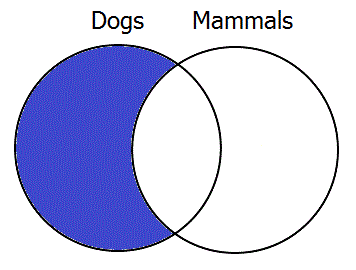
Now, let's see how to use a Venn diagram to construct a counter-example. Here's the diagram representing the premiss of the argument as true by showing the part of the diagram representing non-mammal dogs―shaded in blue―is empty:
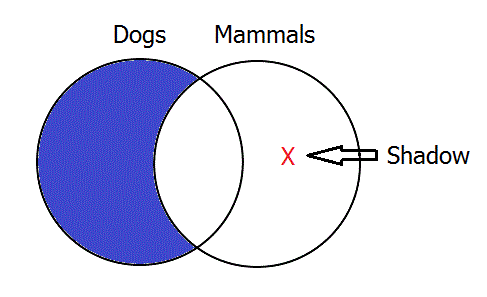
To find a counter-example, we look to see what would make the conclusion false. The diagram does not show the crescent-shaped area on the right, representing non-canine mammals, as empty. Therefore, a counter-example will be any mammal that is not a dog, such as the aforementioned Shadow. This counter-example is shown by the red "X" in the second diagram.
Having seen the basic technique in a simple example, let's look at a more complicated one involving three classes. Consider the categorical syllogism:
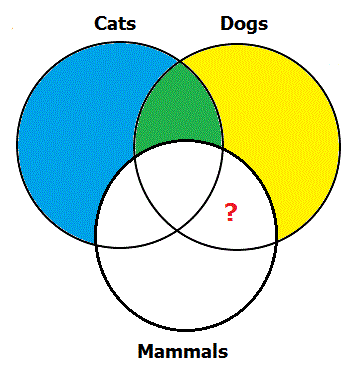
All cats are mammals.
All dogs are mammals.
Therefore, all dogs are cats.
Here's a Venn diagram showing the premisses as true, with the blue shading representing the first premiss and the yellow the second. The conclusion is not shown to be true because the area with a red question mark is not shaded. It's in this area that we need to find a counter-example, that is, a dog that is not a cat, which is easy enough as any dog will do.
While counter-examples are useful for showing invalidity, they are not always available. The previous example was so obviously invalid that a counter-example was scarcely necessary, and it's common knowledge that the conclusion is false. However, not every argument of the same form will be obviously invalid. For instance, consider the argument:
All oranges are citrus fruits.
All mandarins are citrus fruits.
Therefore, all mandarins are oranges.
This argument sounds much more plausible, since its conclusion is true, yet it has the same form as the previous implausible one. As a result, the same diagram serves to represent it with the circles relabeled with "oranges" for "cats", "mandarins" for "dogs", and "citrus fruits" for "mammals". So, despite its plausibility it's invalid. However, a counter-example would have to be a mandarin that is not an orange. Despite the lack of a counter-example, the diagram shows the argument to be invalid since the premisses leave open the possibility that there are non-orange mandarins. Thus, even without a counter-example the diagram shows the argument's invalidity. By the way, both of the above syllogisms commit the fallacy of undistributed middle term3.
In addition to cases where the conclusion of an argument is true for reasons irrelevant to its premisses, counter-examples are not possible when the conclusion is a particular statement, that is, an I or O statement. However, when diagramming such an argument it should be obvious by inspection that the premisses do not make the particular conclusion true, so a counter-example will be unnecessary.
Now, let's practice on a couple of examples. Construct diagrams for the following arguments and counter-examples if possible.
- No bats are birds.
Therefore, no non-birds are non-bats.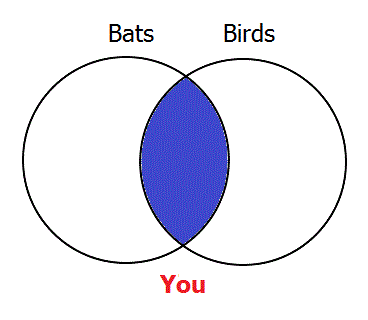
Counter-Example: The conclusion of this argument claims that the class of things outside of both the birds and bats circles is empty. So, anything that is neither a bird nor a bat, such as you, is a counter-example. This argument commits the fallacy of illicit contraposition4.
- No fascists are communists.
All communists are socialists.
Therefore, no fascists are socialists.
Counter-Example: The Nazis were national socialists, so they fall in the area of the diagram that would have to be empty for the conclusion to be true. This syllogism commits the fallacy of illicit distribution of the minor term5.
Notes:
- ↑ See:
- Class Diagrams, 6/22/2016
- Two-Circle Venn Diagrams, 6/22/2016
- Categorical Statements, 8/17/2016
- Equivalence, 11/15/2016
- Contradiction, 12/13/2016
- The Third Circle, 2/16/2017
- Pretzel Logic, 4/28/2017
- Categorical Syllogisms, 5/22/2017
- Polysyllogisms, 6/19/2025
- ↑ See: Illicit Conversion
- ↑ See: Undistributed Middle Term
- ↑ See: Illicit Contraposition
- ↑ See: Illicit Minor
July 16th, 2025 (Permalink)
Striking a False Note
The following passage from this month's New Book1 caught my eye:
Over the years, supposedly scientific claims about everything from healthy eating to brain function have propagated widely, often from unexpected or unknown sources. For example, it's often claimed that adults should drink eight glasses of water a day, even though this advice doesn't have a clear origin. It may stem from health advice published in 1945, which stated "a suitable allowance of water for adults is 2.5 litres daily in most instances." However, that advice also noted that "most of this quantity is contained in prepared foods."2
This got my attention because I've heard this urban legend since I was a child, but have always been skeptical of it and even researched and written about it3. Despite that, I had never come across the two-and-a-half liters claim. Two-and-a-half liters is about 85 fluid ounces or more4, whereas eight eight-ounce glasses is only 64 ounces. While eight twelve-ounce glasses would work with room to spare, two-and-a-half liters doesn't naturally divide into eight glasses. In addition, I've done some research and documented that the eight glasses a day claim goes back to at least 1924. So, the two-and-a-half liters claim is not the source of the eight-and-a-half glasses one.
When reading a non-fiction book, it's good advice to check a few notes at random, assuming that the book actually has notes of some sort. If it doesn't, that's a mark against it since it makes it extremely difficult if not impossible to check the book's factual claims. If one or more references fails such a random check, that's a bad sign: either the author or editors were lazy―or worse. When it comes to misleading notes, keep in mind Goldfinger's Axiom: Once is happenstance, twice is coincidence, the third time it's enemy action5.
In this particular case, I was prompted to look for a note only because I was curious about the author's source for this claim. The book does indeed have endnotes―a lot of them in fact. So, the book passes muster on that score. However, the only endnote close to the claim in question is at the end of the entire paragraph quoted from above. That note points to a short article with the title "Accuracy of comparing bone quality to chocolate bars for patient information purposes: observational study"6, which sounds like a practical joke. Nonetheless, it was published in the prestigious British Medical Journal (BMJ).
The authors tested twenty candy bars―which was apparently all they could afford on their research budget―by dropping them on the kitchen floor―yes, an actual floor in a kitchen―from increasing heights until they fractured. What happened to the candy after the experiment ended was not reported.
It's an amusing article, and not much more ridiculous than a lot of the seemingly serious research I've documented in this weblog. However, what it has to do with how much water you should drink, I don't know, though I expect the researchers needed some to wash down the candy bars. Moreover, this research is not referred to in the paragraph footnoted, nor is there any other reference to it in the remainder of the book as far as I can tell.
So, the note turned out to be a dead end, but the paragraph directly quoted a source twice, and a search for the two quotes turned up what must be that source7. The short article in question debunks seven "medical myths", including that you should drink eight glasses of water a day. It was also published in the BMJ preceding the candy article in the same issue, and the URLs for the two online versions of the articles differ only in the final digit which, presumably, was miscopied.
So, this note was probably the result of a simple typographical error, but it's an amusing example of what can be a serious issue. Readers tend to rely on the notes to support a book's factual claims, but they don't always do so. Naturally enough, most people don't check notes, and even those of us who might occasionally do so don't check them all. Most books that include notes at all often have too many to check; for instance, Proof has over five-hundred. I checked a few other notes in the book without encountering any problems, so I'll put this one down to happenstance.
Notes:
- ↑ See: New Book: Proof, 7/2/2025.
- ↑ Adam Kucharski, Proof: The Art and Science of Certainty (2025), p. 222.
- ↑ See: "Emerging Evidence", 1/9/2023.
- ↑ "What is 2.5 liters in fluid ounces?", Wolfram Alpha, accessed: 7/15/2025. To be exact, it's 84.5 American fluid ounces but 88 in the United Kingdom―go figure.
- ↑ See: Ian Fleming, Goldfinger (1959), epigraph.
- ↑ Phil Jones, Sarah Jones & Debbie Stone, "Accuracy of comparing bone quality to chocolate bars for patient information purposes: observational study", British Medical Journal, 12/22/2007.
- ↑ Rachel C. Vreeman & Aaron E Carroll, "Medical Myths", British Medical Journal, 12/20/2007.
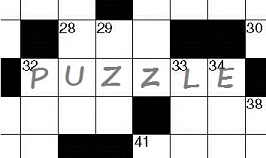
July 4th, 2025 (Permalink)
The Fourth of July Picnic
At the Logicians' Club July Fourth picnic, hot dogs were served. Three condiments were available for the frankfurters: mustard, ketchup, and pickle relish. Of the forty-one people who attended the picnic―logicians and their families―all used at least one condiment on their hot dogs, except for one little boy who ate his plain. Twenty-six attendees put mustard on their hot dogs, sixteen used ketchup, and eighteen added relish. Five picnickers put both mustard and ketchup on their frankfurters, six had both ketchup and relish, while three had all three condiments.
Question: How many people had both mustard and relish but no ketchup on their hot dogs?
Try solving the puzzle with a Venn diagram; see: Using Venn Diagrams to Solve Puzzles, Part 2. You probably won't be able to solve it completely this way, but it will help.
You can use trial and error to solve the final step in this puzzle solution, or a simple application of algebra―don't complain that you never get a chance to use your high school algebra!
Nine people had both mustard and relish but no ketchup on their hot dogs.
Disclaimer: The above puzzle is a work of fiction: no one would ever put both mustard and ketchup on a hot dog.
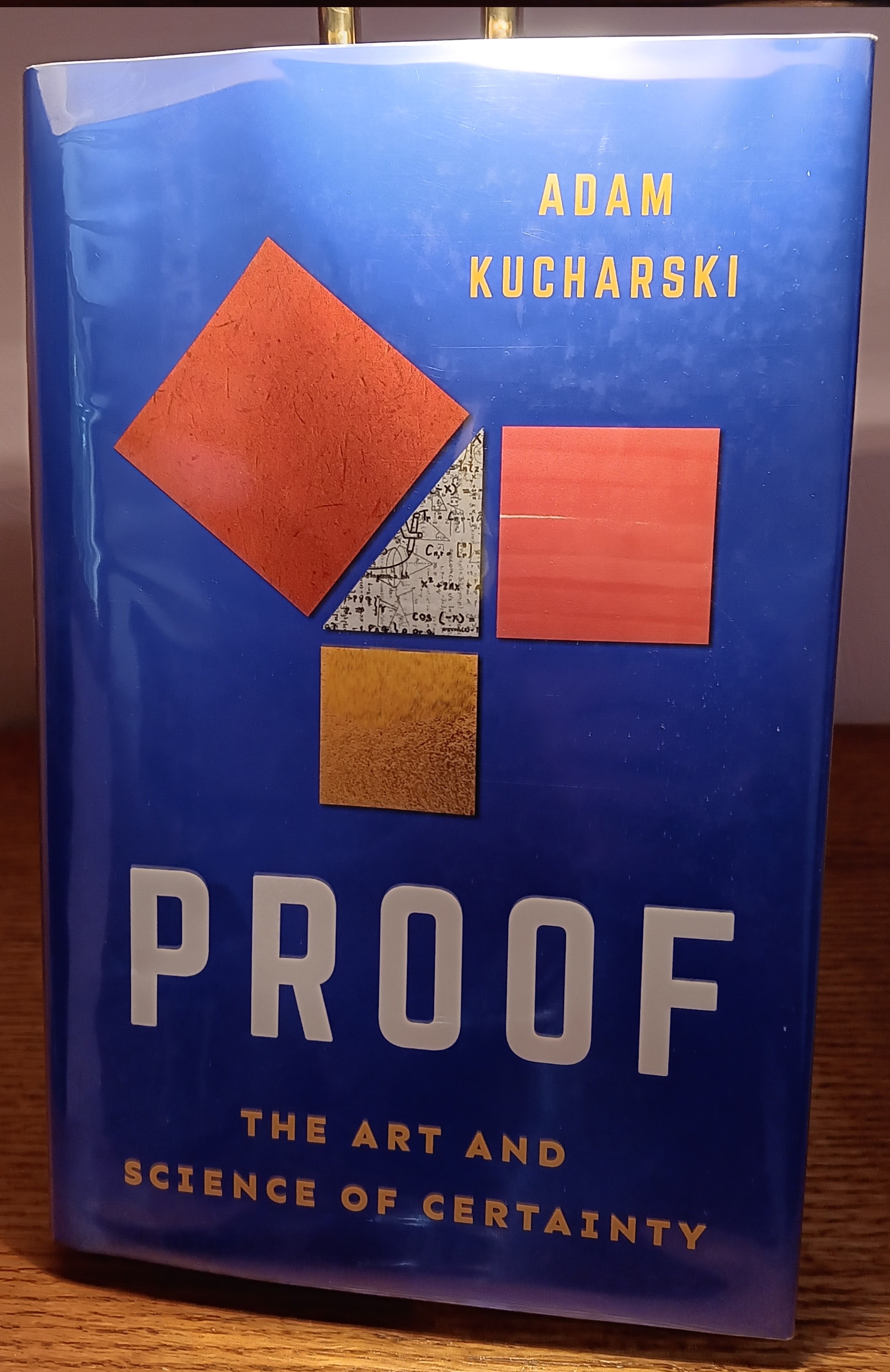
July 2nd, 2025 (Permalink)
New Book: Proof
Quote: "Life is full of situations that can reveal remarkably large gaps in our understanding of what is true and why it's true. This is a book about those gaps. It is the story of the ideas that have helped scientists and societies discern between truth and falsehoods, improving decision-making and reducing dangerous errors. From medieval juries to modern scientific revolutions, it is about the methods people have used to accumulate evidence, negotiate uncertainty, and converge on proof. And, crucially, what happens when those methods fail."1
Title: Proof
Subtitles: This book has different subtitles for its United Kingdom and United States editions:
- UK: The Uncertain Science of Certainty2
Comment: This is certainly an intriguing subtitle, but I'm uncertain what it means. The science of certainty would seem to refer to formal logic, but what's uncertain about it?
- US: The Art and Science of Certainty
Comment: What is meant by "the art…of certainty"? The invocation of certainty, like the word "proof", suggests the logical and mathematical, as opposed to more informal notions, of "proof". I'll have more to say about these ideas in the General Comments, below.
I wonder why it was thought advisable to have different subtitles for the US and UK. All of this, of course, may have little to do with the book or its author, since the subtitles may have been selected by the book's publisher. Was there some reason to think that the second subtitle would sell better here in the US than the first, or that the first would sell better in the UK?
Author: Adam Kucharski
Comment: Please don't hold it against him, or against me, but I'd never heard of Kucharski prior to this book. Based on the author's short biography at the end of the book, he is a mathematician and epidemiologist, and has written two previous books―The Perfect Bet and The Rules of Contagion―neither of which I've read.
Date: 2025
Summary: So far, I've read only the Introduction to the book, which lacks a summary of its structure, and the chapter titles are not very revealing, so I'm guessing as to the topics covered. Beside the Introduction, there are eight chapters. I suppose that the first chapter is an introductory one; the second appears to concern "proof" in the fullest sense, that is, in logic and mathematics; the third, in contrast, seems to deal with the weaker sense of "proof" used in the law and legal trials; the fourth would seem to concern the sense of "proof" in the statistical trials of medical and social research; the penultimate chapter may have something to do with computers; and the last may be a summing up since there is no afterword.
Given that Kucharski is an epidemiologist, I was curious whether he discusses the events of the last few years in the book. None of the chapter titles suggest a concern with the pandemic, though the fourth is a likely suspect. Thankfully, the index indicates that, unlike Marty Makary, author of a previous New Book3, Kucharski does treat the pandemic at some length.
The Blurbs: The book is positively blurbed by Tim Harford, author of The Data Detective, and Alex Bellos, who wrote Can You Solve My Problems?, both of which I've read.
General Comments: "Proof" has both a strong and a weak sense:
- Strong: The strong sense of proof is that which occurs in deductive logical and mathematical contexts. In this sense, a proof is an argument that's valid. This means that if the premisses of the proof are true then the conclusion must also be true. It does not mean that the conclusion of the proof is true, let alone necessarily so, since one or more of the premisses might not be true. It would appear to be this sense of "proof" that's discussed in chapter four of the new book.
- Weak: A proof in this weaker sense is one that makes its conclusion more likely to be true than false, but not necessarily so. This sense is weaker than the strong one in that the premisses of such a proof could be true and the conclusion false. For instance, the legal standard of "beyond a reasonable doubt" is not a proof in the strong sense since it does not mean beyond any doubt whatsoever, and it's possible that an innocent person might be convicted of a crime based on evidence that meets the standard. Similarly, the evidence supporting a theory in empirical science never amounts to a proof in the strong sense as there is always a possibility that new evidence will refute it. This sense would seem to be the subject of chapters three and four.
I plan to read this book and may have more to say about it in the near future.
Disclaimer: I haven't read this book yet, so can't review or recommend it, but its topic is right in the wheelhouse of my bailiwick, so I'm interested in it and thought that readers might be as well.
Notes:
- ↑ "Introduction", p. 3.
- ↑ For the UK cover with subtitle, see: "Proof: The Uncertain Science of Certainty", Adam Kucharski, accessed: 7/1/2025.
- ↑ New Book, 3/27/2025.